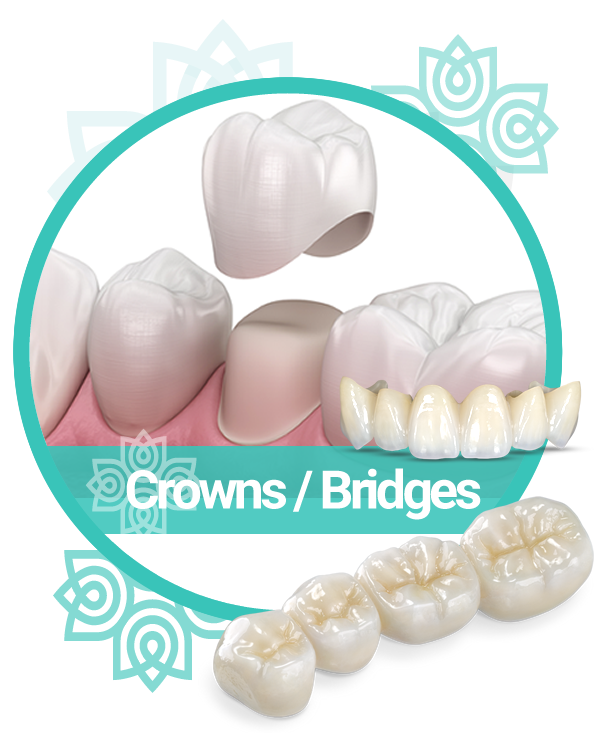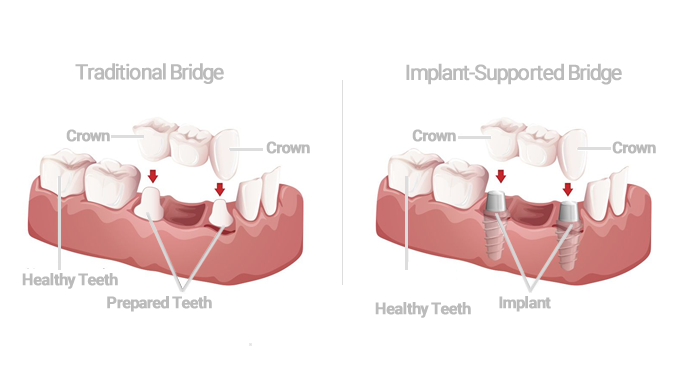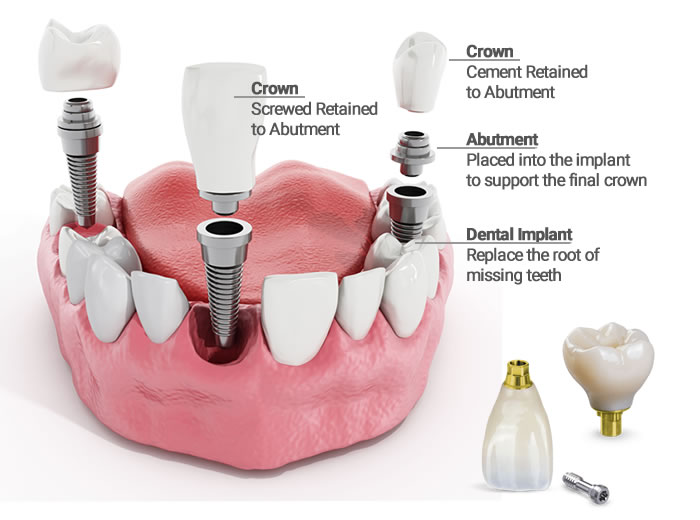
CROWN & BRIDGE RESTORATIONS
A DENTAL CROWN IS A TOOTH-SHAPED «CAP» THAT IS PLACED OVER A TOOTH TO RESTORE ITS SHAPE AND SIZE, STRENGTH, AND IMPROVE ITS APPEARANCE.
Crowns (sometimes known as caps) are a type of dental restoration used to protect teeth that have become damaged, broken or cracked. Instead of replacing the damaged tooth, a crown is used to strengthen the existing tooth and preserve it’s usefulness. Here are some of the key advantages:
| Restoration of Tooth Structure | Improved Chewing and Speaking |
|---|---|
| Aesthetic Enhancement | Maintains Facial Structure |
| Support for Dental Implants | Stabilizes Adjacent Teeth |
| Protection after Root Canal |
Crowns can be made from a variety of materials and even combinations of different materials. However some materials are more aesthetically pleasing than others.
WHAT ARE EXACTLY DENTAL CROWNS?
Zirconia crowns are made through a multi-step process that involves careful planning, preparation of the tooth, and the fabrication of the crown.
The process begins with a thorough examination and diagnosis by a dentist. X-rays and impressions may be taken to assess the extent of damage or decay in the tooth.
To make room for the zirconia crown, the affected tooth is prepared. This involves removing any damaged or decayed tissue and reshaping the tooth to create a suitable foundation for the crown.
After tooth preparation, an impression (mold) of the prepared tooth and surrounding teeth is taken. This impression is used to create an accurate replica of the tooth and its alignment within the mouth.
In some cases, a temporary crown may be placed on the prepared tooth while the permanent zirconia crown is being fabricated. This temporary crown protects the tooth and maintains its appearance.
- The dental impression is sent to a dental laboratory where skilled technicians use computer-aided design (CAD) and computer-aided manufacturing (CAM) technology to create the zirconia crown.
- A block of zirconia material is milled or shaped into the desired crown shape based on the digital design.
- The zirconia crown is then sintered (heated at high temperatures) to achieve its final hardness and strength.
- The crown may be further customized with shading and characterization to match the patient’s natural teeth.
The fabricated zirconia crown undergoes quality control checks to ensure that it meets the dentist’s specifications and standards for fit and appearance.
Placement:
-
- Once the zirconia crown is ready, the temporary crown (if used) is removed, and the permanent zirconia crown is placed on the prepared tooth.
- The dentist carefully checks the fit and bite to ensure proper alignment and function.
- Any necessary adjustments are made to ensure a comfortable and functional fit.
After proper fit and bite are confirmed, the zirconia crown is permanently cemented onto the tooth using dental adhesive or cement. Excess cement is removed, and the crown is polished to a natural appearance.
The dentist evaluates the patient’s bite and ensures that the zirconia crown blends seamlessly with the surrounding teeth for a natural look.
USES OF CROWNS & BRIDGES
| To protect a weak tooth (for instance, from decay) from breaking. | |
|---|---|
| To hold together parts of a cracked tooth. | |
| To restore an already broken tooth or a tooth that has been severely worn down. | |
| To cover and support a tooth with a large filling when there isn’t a lot of tooth left. | |
| To cover misshapened or severely discolored teeth to make cosmetic modification | |
| To cover a dental implant or hold a dental bridge in place |
REGURAL CROWNS Vs. IMPLANT CROWNS
- Implant Fixture: The implant fixture is a screw-like post made of biocompatible materials such as titanium that is surgically placed into the jawbone. It serves as the artificial tooth root, anchoring the crown securely in place.
- Abutment: The abutment is a connector piece that attaches to the implant fixture. It protrudes above the gumline and provides a stable foundation for the crown. Abutments can be made from various materials, including titanium, zirconia, or even certain types of ceramics.
- Crown: The crown is the visible part of the dental implant restoration that resembles a natural tooth. Crowns are custom-made to match the shape, size, and color of your natural teeth, ensuring a seamless and natural appearance. They are typically made from materials such as porcelain, zirconia, or a combination of materials for optimal aesthetics and strength.
- Screw or Cement: The crown is secured to the abutment using a screw or dental cement. In some cases, the crown is screwed onto the abutment, allowing for easier future removal if necessary. In others, it may be permanently cemented in place.
- Porcelain or Ceramic Material: The visible portion of the crown is often made from porcelain or ceramic materials. These materials are chosen for their ability to mimic the appearance of natural teeth, including color, translucency, and texture. They are also biocompatible and resistant to staining.
- Connector: In cases where the crown is screw-retained, a small connector is used to secure the crown to the abutment. This connector is usually hidden within the crown and provides a stable attachment.
- Gum Line Contouring: The crown may be designed with an appropriate contour at the gum line to create a natural transition between the crown and the surrounding gum tissue. This helps achieve a lifelike appearance and ensures the implant crown integrates well with the rest of the smile.
COMPARING DIFFERENT MATERIALS USED TO FABRICATE CROWNS AND BRIDGES
Crowns can be made from a variety of materials and even combinations of different materials. However some materials are more aesthetically pleasing than others. For example crowns made from a combination of metal and porcelain may create dark gum lines over time that are highly visible. For a natural look it is recommended that you opt for a ceramic or porcelain crown. The cost of crowns vary according to what material is used and price can often reflect the quality of the material. The life of a crown can often depend on your oral hygiene. Just like natural teeth, your dental crowns need looking after and if you maintain a good level of oral hygiene then a crown made from quality material can last upwards of 10 years. Some of the most frequently used types of crown include:
By far the most aesthetically discreet option, ceramic crowns are one of the most popular. As no metal is used, ceramic crowns allow light to be transmitted through them creating a more life-like look. Also it can be used for the treatment of small areas. Similarly as there’s no metal, the crown can be used to treat areas. Despite many innovations in the durability and strength of ceramic crowns, they are usually not used in areas of the mouth that undergo heavy usage.
The porcelain/metal combinations provides both an aesthetically discreet and highly durable option. It’s important to note that the appearance of the crown relies heavily on the skill of the laboratory that creates it. This type of crown has a tendency to show underlying metal at the gum line over time. However, rapid innovations in dental technology mean there are many types of metal crowns that can be used to avoid the need for repalcement later in life this.
Although not as aesthetically discreet as other types of crowns , these are still the best option for many patients. If you grind or clench your teeth then the strength and durability of a gold crown is right for you. Gold crowns are commonly recommended to patients with a strong bite or for crowns located at the back of the mouth. In general, they last longer and tend to prevent wearing, as they aren’t as abrasive to the opposing teeth as other materials.
The use of pink porcelain in dentistry allows dental professionals to achieve more natural and pleasing results when restoring missing teeth or improving the appearance of the gums. It is an important component of dental prosthetics, especially when creating restorations that are highly visible in the smile zone. Dental technicians use their artistic skills to shape and color pink porcelain to match the patient’s individual gum characteristics, ensuring that the final restoration looks as natural as possible.
WHAT IS PINK PORCELAIN AND WHEN IS IT USED IN CROWN FABRICATION
Pink porcelain, also known as gingival porcelain or gum-colored porcelain, is a type of dental ceramic material used in dentistry. It is designed to mimic the color and appearance of gum tissue. Pink porcelain is used in various dental prosthetic applications to create lifelike and esthetically pleasing restorations.
Pink porcelain can be used as a component of dental crowns and bridges to replicate the appearance of gum tissue where the restoration meets the natural gumline. This helps create a seamless transition between the restoration and the surrounding gums, making the prosthetic teeth look more natural.
When dental implants are used to replace missing teeth, pink porcelain is often employed to simulate the gum tissue around the implant abutment. This ensures that the implant-supported crown or bridge blends in with the patient’s natural gums.
In cases where patients have partial dentures with artificial teeth replacing missing natural teeth, pink porcelain can be used to replicate the appearance of gum tissue where the denture rests against the gums.
Overdentures are complete dentures that are supported by dental implants. Pink porcelain is utilized to create a lifelike gum appearance around the implant abutments, enhancing the aesthetic result of the overdenture.
Pink porcelain can be used for esthetic corrections in cases where there are issues with the color or contour of the natural gum tissue. It can help improve the overall appearance of the smile.


















